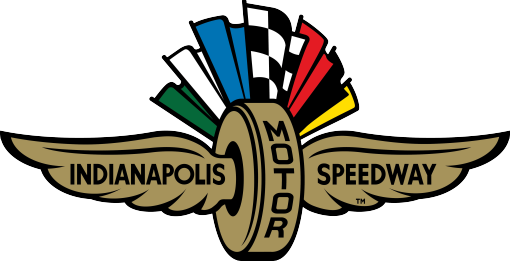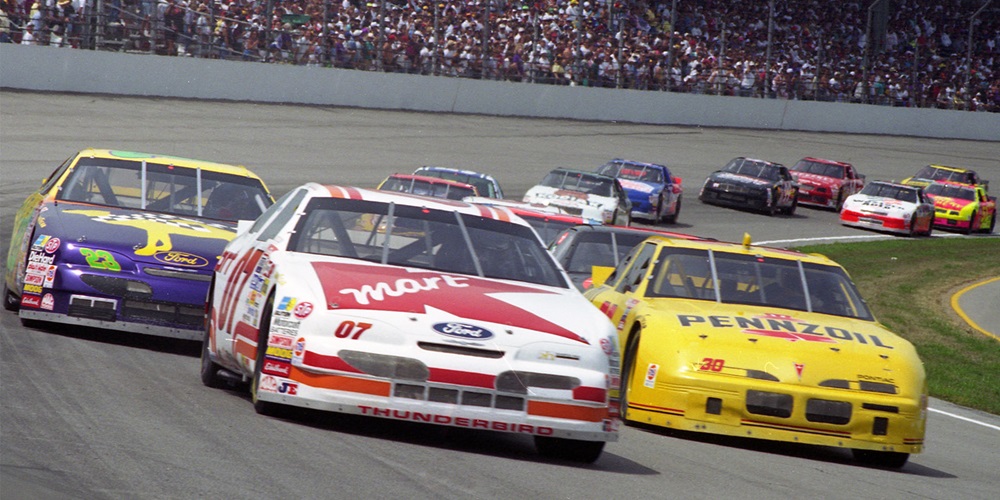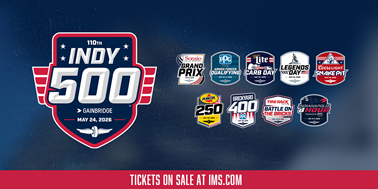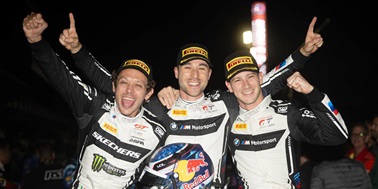1994
Jeff Gordon’s victory in the inaugural Brickyard 400 on Aug. 6, 1994 was his second career NASCAR Cup Series win, but there was no question it was one of the most significant events in American auto racing history.
Gordon became the first driver to win a race at IMS in a stock car, as only open-wheel Indy cars had raced at the fabled facility since it opened in 1909. His win at the most famous racetrack in the world also further ignited a new explosion of popularity for NASCAR that expanded its fan base far beyond its traditional Deep South roots, helping to also trigger a track construction boom in the late 90s that saw ovals built all over the United States.
Legendary seven-time Cup champion Dale Earnhardt started second beside surprise pole sitter Rick Mast, but his usual aggression cost him after brushing the wall while trying to take the lead in Turn 1 at the start. His No. 3 Goodwrench Chevrolet started to drop through the field, and Earnhardt ended up fifth, leading just two laps.
Geoff and Brett Bodine battled for the lead on Lap 100 of the 160-lap race, with contact between the two feuding brothers in Turn 3 that helped Geoff take the lead. But Brett exacted revenge in the next corner, hitting his brother into a spin that also collected Dale Jarrett.
Gordon, who started third in the No. 24 DuPont Chevrolet, slipped past Ernie Irvan on Lap 145 but couldn’t pull away. Irvan went high in Turn 3 and passed Gordon in Turn 4 on Lap 150.
It appeared Gordon would wait until the final few laps to make a move for the win. But Irvan slid high in Turn 1 on Lap 156 after apparently running over debris on the frontstretch, and Gordon pounced.
Gordon dove under Irvan’s car and grabbed the lead, the 21st lead change of the day. Gordon crossed the finish line 0.53 of a second ahead of Brett Bodine.
1995
The 1995 race was worth the wait for Dale Earnhardt, in more ways than one.
Legendary seven-time Cup champion Earnhardt was at the peak of his substantial skills when NASCAR first raced at IMS in 1994, the odds-on favorite to win the inaugural. He started second and brushed the wall early while fighting pole sitter Rick Mast for the lead and never recovered, finishing fifth.
One year later, Earnhardt returned as the race favorite. But “The Intimidator” and the rest of the field had to wait out a rain delay of four hours to start the race as the remnants of Hurricane Erin rumbled through Indiana.
Once the race started, one of the cleanest and fastest Brickyard races unfolded, with just one caution slowing the action. Reigning race winner Jeff Gordon won the pole, and 1988 Cup champion Bill Elliott led the most laps, with 47.
Earnhardt, who started 13th in the No. 3 Goodwrench Chevrolet, only led once – when it counted. He took the lead on Lap 137 and led the last 28 laps to edge fellow Cup champion and rival Rusty Wallace by 0.37 of a second as the checkered flew at 8:03 p.m. (ET), shortly before sunset.
Wallace’s runner-up finish was heartbreaking. He held a commanding lead on Earnhardt when pitting on Lap 129 but got caught behind a pit-lane accident involving Joe Nemechek and Rich Bickle. That delay let Earnhardt take the lead.
The final dash to the checkered was far from a joyride for Earnhardt. He narrowly missed the spinning car of Jeff Burton right after taking the lead on Lap 133, an accident that triggered the only caution period of the race.
1996
The third annual NASCAR Cup Series race at IMS featured a stirring duel between Dale Jarrett and Ernie Irvan for victory, but this race will be remembered more for what happened after the checkered flag flew.
Inaugural Brickyard winner Jeff Gordon won the pole for the second consecutive year, but his chances for a second victory ended when a flat tire sent him into the Turn 4 wall on Lap 24. Gordon ended up 37th.
Unheralded Johnny Benson Jr. then dominated the race between Laps 32-120, leading three times for a race-high 70 laps before a mistake on a pit stop on Lap 125 dropped him from contention.
Then Jarrett and Robert Yates Racing teammate and Brickyard standout Irvan began a stirring duel for the victory. Irvan passed Jarrett for the lead in Turn 3 on Lap 139, but Jarrett drove past Irvan in Turn 2 on Lap 154.
Irvan never got a chance to make one final run at his teammate, as Robert Pressley crashed in Turn 4 on Lap 158 and the last two laps were run under caution.
After the race, Jarrett and crew chief Todd Parrott made an impromptu trip to the Yard of Bricks start-finish line to celebrate their victory and honor the special history of IMS. They knelt, placed their lips on the Yard of Bricks and made a smooch heard ‘round the racing world.
It was the first time any driver made the gesture repeated by every Brickyard winner and most Indianapolis 500 winners since then.
1997
As the remaining laps ticked down in the 1997 Brickyard 400, the level of skepticism and incredulity climbed.
There’s no way Ricky Rudd could do it. There’s no way he could go more than a quarter of the 160-lap distance without running out of gas, was there?
There was. He did it.
Veteran Rudd scored one of the most popular victories in the history of the annual NASCAR Cup Series race at IMS on Aug. 2, 1997 when he seemingly did the impossible by stretching his last fuel run to a mind-boggling 46 laps.
He became the first – and only – driver-owner to win this marquee event, his No. 10 Rudd Performance Motorsports Ford crossing the Yard of Bricks 0.183 of a second in front of Bobby Labonte. It’s still the closest finish in the history of this race.
Rudd led Lap 114, when he made his final pit stop. He took the lead on Lap 147 when leader Jeff Burton was penalized for speeding on his final pit stop.
The huge crowd held its collective breath over the last 14 laps to see if Rudd could hold off a charging Labonte while stretching his fuel run to the checkered flag. A three-lap caution period ensured Rudd made it to the finish ahead of Labonte.
Rudd finally ran out of gas – on the cooldown lap as he prepared to enter Victory Lane for the biggest win of his career.
1998
Maybe it was an omen. Jeff Gordon started third in the inaugural Brickyard 400 and won.
He also qualified third in 1998 – his only other starting spot from that position in 23 career Brickyard races – and won.
Gordon became the first driver to win this race twice, again in the familiar rainbow-colored No. 24 DuPont Chevrolet owned by Hendrick Motorsports with crew chief Ray Evernham calling the shots.
There was also one other common thread between the two wins: Gordon crushed the field. In 1994, he led 93 of the 160 laps. Gordon bettered that in 1998 by leading 97 of 160 laps. No other driver led more than 27.
1996 Brickyard winner Dale Jarrett appeared to be the only equal to Gordon in the first half of the race. But Jarrett’s goal to become the race’s first two-time winner ended when a miscalculation in the pits resulted in him running out of fuel while leading by four seconds on Lap 80, coasting to a stop at the head of pit road. Jarrett lost four laps while his Robert Yates team sprinted up pit road to push his car to his pit stall. Jarrett made up all four laps through strategy and well-timed caution periods, but he ended up 16th.
Gordon then smashed the competition, leading 69 of the last 77 laps. That victory was rewarded with a winner’s purse of $1,637,625, boosted by a $1 million Winston No Bull 5 bonus. That remains the largest winner’s haul in the history of the race.
1999
Dale Jarrett wasn’t about to let this one slip away.
1996 winner Jarrett was poised to become the first two-time champion of this race in 1998 when his No. 88 Robert Yates Ford ran out of gas while leading by four seconds at the halfway point.
Crew chief Todd Parrott calculated fuel mileage accurately this year to help Jarrett become the second two-time winner of this race and also earn another trip to the start-finish line to kiss the Yard of Bricks, a tradition he and Parrott started after their first win in 1996.
Jarrett led 117 of the 160 laps, showing the same dominance before running out of gas in 1998. But a potential fuel problem arose late in the race that again could have foiled Jarrett’s chances.
With 20 laps to go, Bobby Labonte was the only driver among the leading group of cars that was certain he could reach the finish without a stop for fuel. Jarrett stopped on Lap 118, with 42 laps to go, and had averaged around 40 laps per tank earlier in the race.
But Jarrett got the break he needed on Lap 143 when the last of three caution periods began for oil on the track. Jarrett dove into the pits and surprised the field by taking just two tires.
That strategic wizardry by Parrott gave Jarrett all the margin – on the track and in his gas tank – that he needed. He beat Labonte to the finish by 3.351 seconds.




